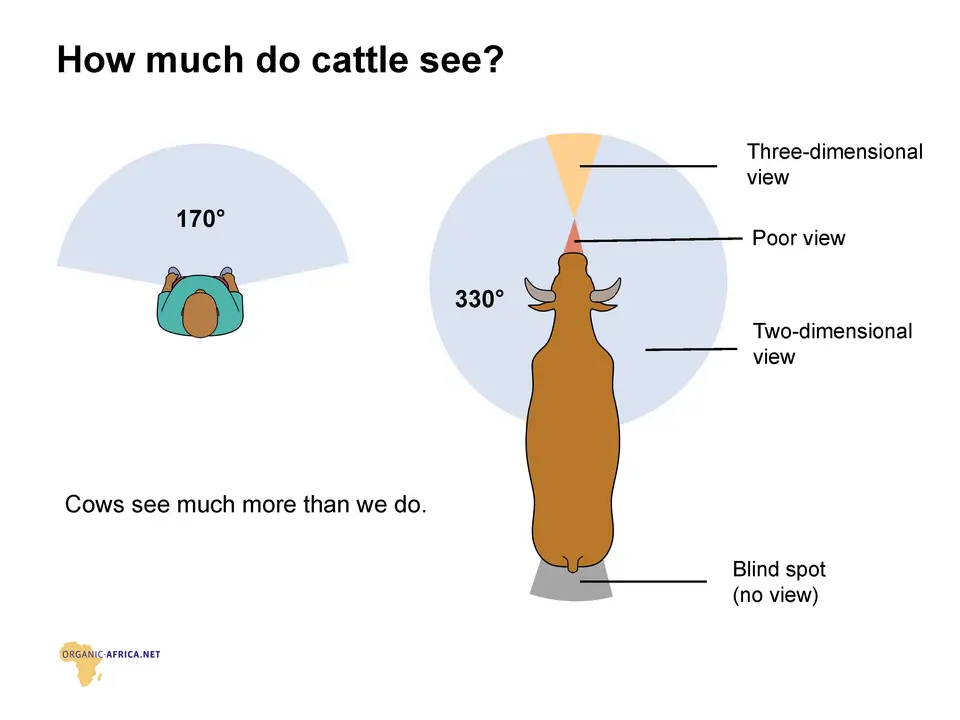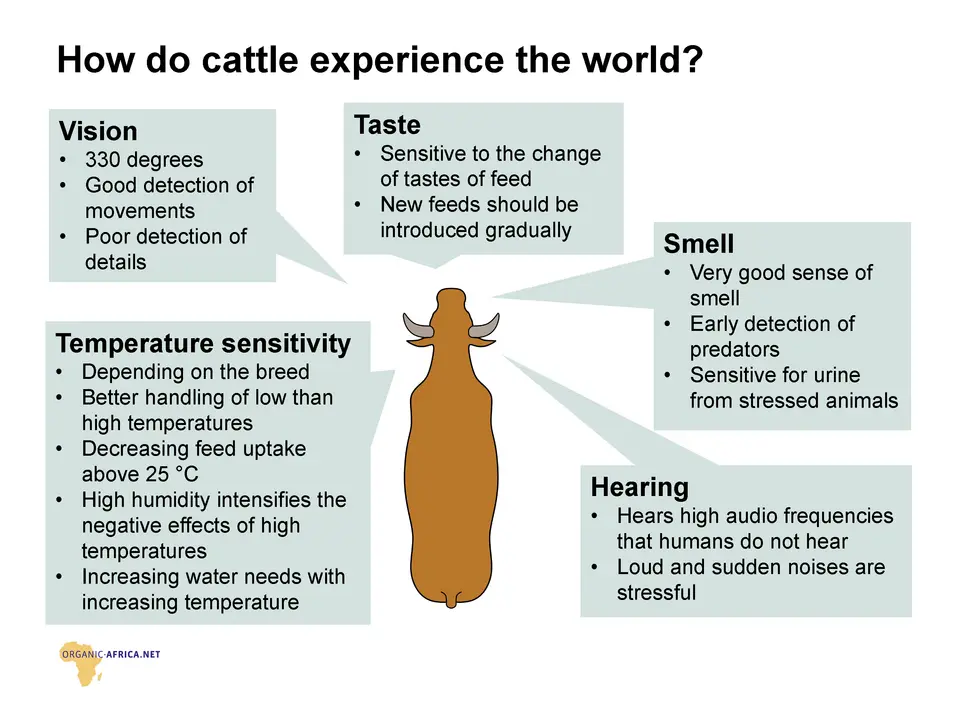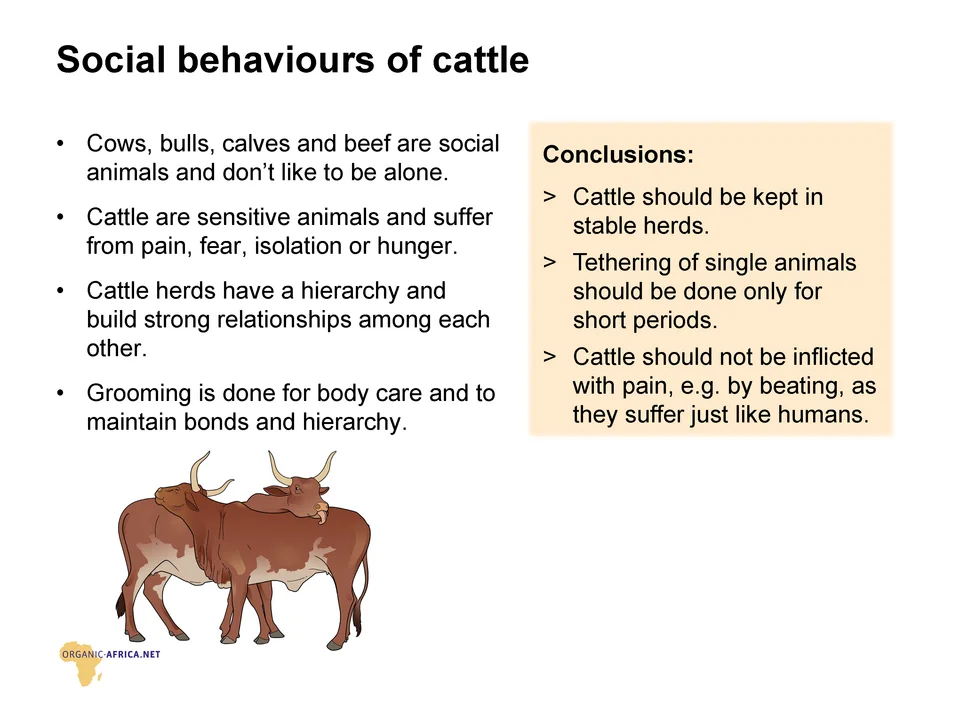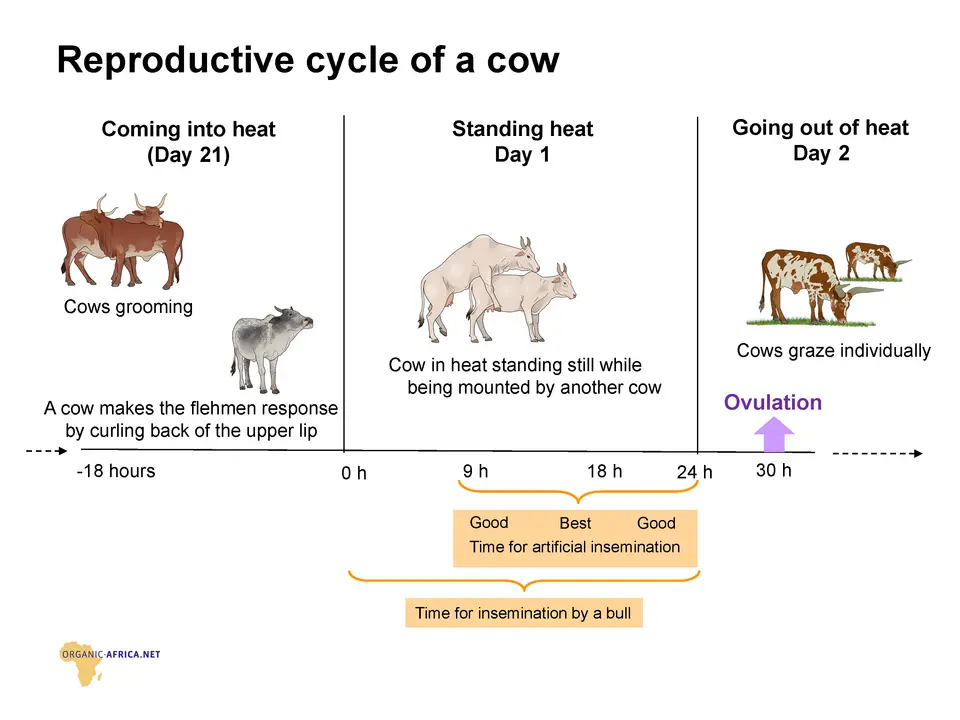Natural Behaviour
Cattle’s five senses
1. Vision
- While cattle have 330 degrees of vision, they can only see sharply what is in front of them.
- To inspect an object, they lower their heads.
- With their side vision, they can observe moving objects well but judge distance poorly. This is useful for them to see potential predators.
- The spot directly behind the cow is called the blind spot. If you stand there, the cow cannot see you.
This information about the cow’s vision can be used to the handler`s advantage when approaching a cow: If a handler wants to cause a cow to move, they can simply approach from the side, where the cow has poorer depth perception, and will naturally want to move away. Attempting to move an animal by standing directly in front of or behind is not a good idea, as the animal may be spooked or provoked.
2. Hearing
- Cattle have sensitive hearing and can hear high acoustic frequencies, which humans are not able to hear.
- To locate the source of noise, cattle turn the ears or the head around and also use sight to identify the source of the noise.
- Loud and sudden noises can be very stressful for cattle and lead to panicky behaviour, which can be dangerous for people and other animals.
Therefore, loud and disruptive noises should be minimised in proximity to animals to avoid unexpected and risky behaviour of cattle.
3. Smell
- Cattle have a very good sense of smell in part because this enables them to detect predators early.
- Cattle can smell odours at a distance of several kilometres.
- They also avoid places with unpleasant smells or urine from stressed animals.
Therefore, stress among the animals should be avoided, and the animal area should be kept clean and dry.
4. Taste
- Like humans, cattle can identify different tastes with their tongue.
- Compared to people, cattle are more sensitive to tastes and can be apprehensive when it comes to eating novel feedstuffs with unfamiliar tastes or smells.
Therefore, feeds or their composition should not be changed abruptly and the changeover to new feeds should be approached gradually in order to prevent a sharp drop in feed intake.
5. Temperature sensitivity
- Not all cattle breeds are equally sensitive to low and high ambient temperatures.
- Most cattle tolerate temperatures down to -23°C.
- But in contrast, most cattle suffer more acutely from high temperatures. Temperatures above 21°C increase their breathing intensity, and temperatures above around 25°C reduce their feed uptake, depending on air humidity.
Grazing during the cooler hours of the day, i.e. in the evening or morning, and offering shade during the hot hours of the day allow cattle to escape high temperatures. Pregnant and lactating cows in particular need significantly more water when temperature increases. If possible, permanent access to sufficient fresh water is beneficial to cattle.
Based on the information on the senses of cattle, discuss in groups, how to behave in the following situations:
- Handling during loading and transport, and at slaughter
- Transferring a herd from one field to another
- Milking of cows
- Separating a cow from the herd for medical treatment
- During very hot temperatures (above 35 °C)
Social behaviours
Cattle are herd animals and are thus highly social. They prefer to be in close proximity to other members of the herd. Cattle groom each other for body care and to maintain bonds within the herd. They also groom to establish and maintain their herd hierarchy, which changes as soon as new animals are added or removed from the herd. New cattle in a herd are normally low in the hierarchy. The introduction of new individuals into a herd often causes disturbance. Isolation of single animals is stressful and can cause panic. Animals that are tethered have a limited possibility to express their social behaviour (e.g. grooming), which can also cause distress and health issues if the tethering lasts for a long time (e.g. more than a few hours per day).
Therefore, cattle should be kept in a herd when possible, and separation of single animals from the herd should be avoided or minimised. Long periods of tethering should be minimised, and the herd should be kept as stable as possible by avoiding the frequent introduction of new animals.
Reproductive behavior
The reproductive behaviour of cows and bulls can also be seen as part of social behaviour. It is of particular importance for breeding and a good understanding of the symptoms is important for successful breeding. Cattle are capable of mating at any time of the year, but most breeding occurs during the wet season. Heat usually lasts for 18 to 24 hours. If a cow is not successfully bred, the heat cycle usually repeats after 21 days. 2 to 3 days before the heat starts, cows become more active and show increasingly typical oestrous behaviours. These include reduced food intake, increased movement, the curling back of the upper lip while smelling (called the flehmen response), standing behind another cow and resting the chin on the back of another cow, and increased licking and sniffing of other cows. If a cow is standing while she is mounted, this is a clear sign of heat. The detection of heat is important, especially in dairy cattle whether artificial insemination will be used or the cow has to be taken to the bull at the right time. In the following diagram you can see the different phases of heat (beginning heat, standing heat, dying heat) and the symptoms of these phases.
The gestation period of cattle is approximately nine months and 10 days, and cows typically give birth to one calf at a time.Read more about the management of cows at the time of birth and the management of calves. Cows are highly protective of their young and will fiercely defend their calf if it is threatened. It is important to be cautious when working with cows and their calves to maintain safety for humans and animals.




 tap and then scroll down to the Add to Home Screen command.
tap and then scroll down to the Add to Home Screen command.